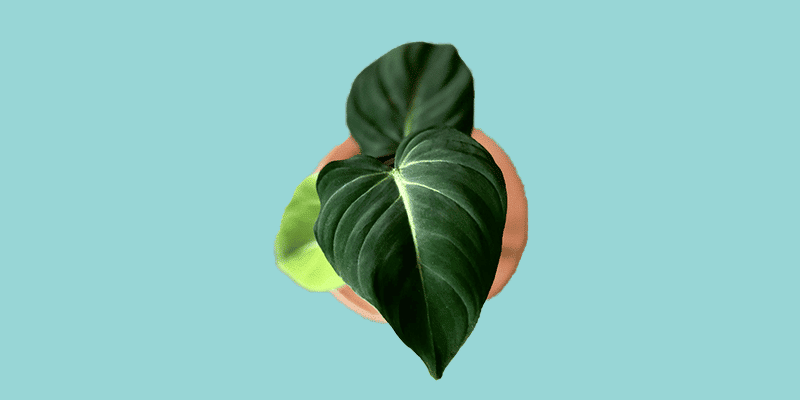Out of all the philodendron species, I am very partial to Philodendron gloriosum.
They say beauty is pain, but Philodendron gloriosum might be the exception to the rule. Growing this eye-catching plant isn’t difficult, and the payoff is magnificent.
Its heart-shaped leaves are large and silky green, changing in color as the plant matures. There are almost limitless varietals to choose from, with leaf vein colors ranging from pink to white, silver to green.
As it’s a crawling philodendron (its stem grows horizontally), it also works in a lot of pots that other plants just can’t pull off.
In this article, I’m going to cover how to properly care for and propagate Philodendron gloriosum indoors, how to avoid yellowing leaves, and deal with the most common issues that come up.
I’ll also cover why the Philodendron species loves a bit of charcoal added to the soil.
Table of Contents
Philodendron Gloriosum Care Guide
History, habitat, and characteristics
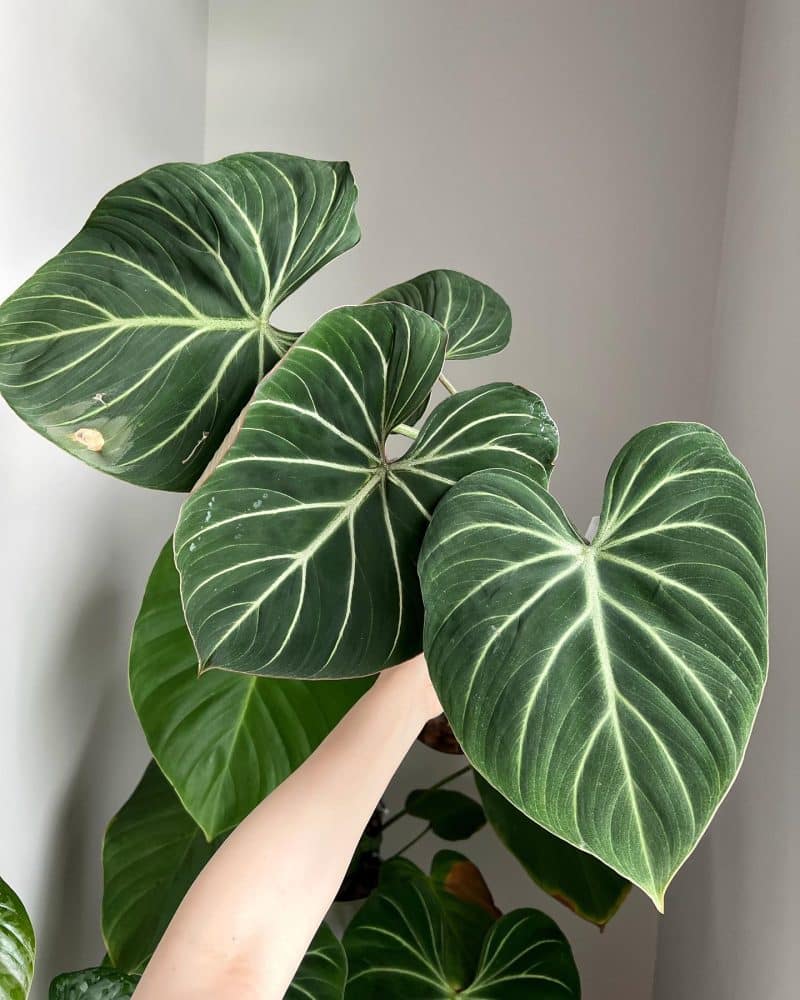
First identified in the Colombian rainforest in 1876 by French botanist Charles Antonine Lemaire, Philodendron gloriosum is part of the Araceae, or aroid, family. It can be found in many tropical parts of the world, including Mexico, Peru, Ecuador, west Brazil, and Venezuela. The plant has even migrated to Hawaii, where it was introduced for commercial selling.
Philodendron gloriosum translates to “glorious tree lover,” referring to its tendency to vine on trees the wild. When cultivated inside, however, P. gloriosum is a terrestrial plant, which means that it grows on land.
In fact, this plant loves to crawl along the ground, shooting up foliage from an underground mother stem called a rhizome.
Although Philodendron gloriosum develops a white bloom each summer from May to July, most people are drawn to its soft velvet leaves. The philodendron gloriosum’s leaves are a light green rimmed by pink when they first open, gradually losing the pink outline and darkening to a deeper green shade.
(Contrast these with the leaves of the Philodendron Brasil which we covered in a separate care guide.)
Leaves usually emerge one by one. This plant rewards patience, since a leaf spike can take over a month to unfurl and an additional month to mature.
We can forgive the philodendron gloriosum for being a slow grower, though, since mature plants can reach up to three feet high and six feet wide.
It may be hard to find the Philodendron gloriosum, as it’s in great demand and can be a bit expensive. The International Union for Conservation of Nature (IUCN) classifies the gloriosum philodendron as vulnerable on its Red List of Threatened Species, which contributes to its scarcity.
Care is pretty simple: philodendron gloriosum is a low-fuss plant that prefers bright, indirect light, mid-high humidity, and coarse potting mix. Next, I’ll cover the best indoor location, watering needs, humidity levels, and soil composition for this plant.
Light
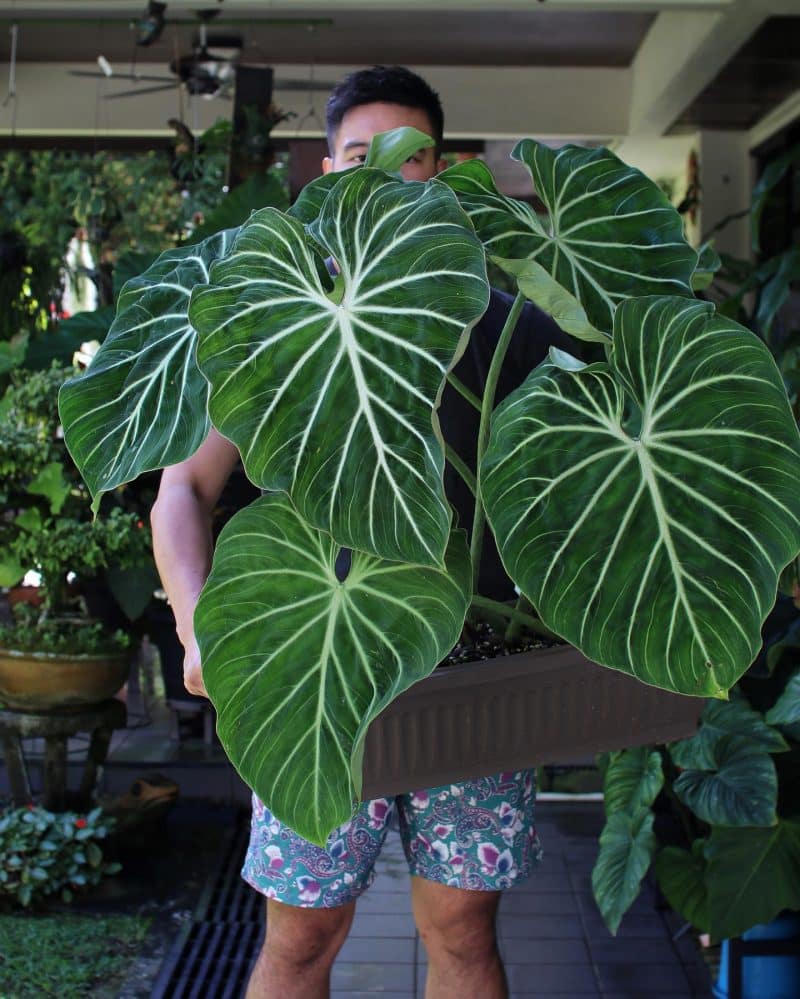
The philodendron gloriosum needs bright indirect sunlight for at least eight hours a day to encourage good plant growth. Depending on your location, keeping the plant two to three feet from a southwest-facing window could be ideal.
Increasing the amount of light your plant gets will expand its leaf size. In the wild, philodendron gloriosum can grow leaves up to three feet high, reaching up to two feet when grown inside.
If the lighting in its environment is too dim, or if you’re growing it very close to the ground, the philodendron gloriosum will look leggy, since it grows slowly and will reach for more light. Add more light and you’ll see less leggy growth.
Too much direct sunlight will cause its leaves to fade and burn, so stick to bright indirect light and your philodendron gloriosum plant will love you for it.
Water
Water your philodendron gloriosum thoroughly once a week week during its growing season, but cut back to every few weeks in winter to avoid root rot. Make sure the upper half of its soil is dry before watering. You can test with a fingertip a few inches deep.
You absolutely want to avoid misting this plant, even if you’re trying to increase its humidity (which I often recommend for other plants). Misting the leaves of this plant will result in damage. If water accumulates on the leaves, wipe them off with a cloth.
Temperature and humidity
Philodendron gloriosum plants like 65-85 degrees Fahrenheit during the day and 60-70 degrees Fahrenheit at night. They don’t appreciate temperature shifts, so don’t keep them near a drafty door or fan and be careful if you’re transporting one from a gardening center in the winter.
As many tropical plants do, Philodendron gloriosum thrives in the warm climate of USDA Zone 11, preferring humidity levels of 60% to 80%. But don’t worry – it can flourish between 40% to 60% humidity in an indoors environment, so there’s no need to turn your house into a sauna (unless you prefer that).
Soil and planting
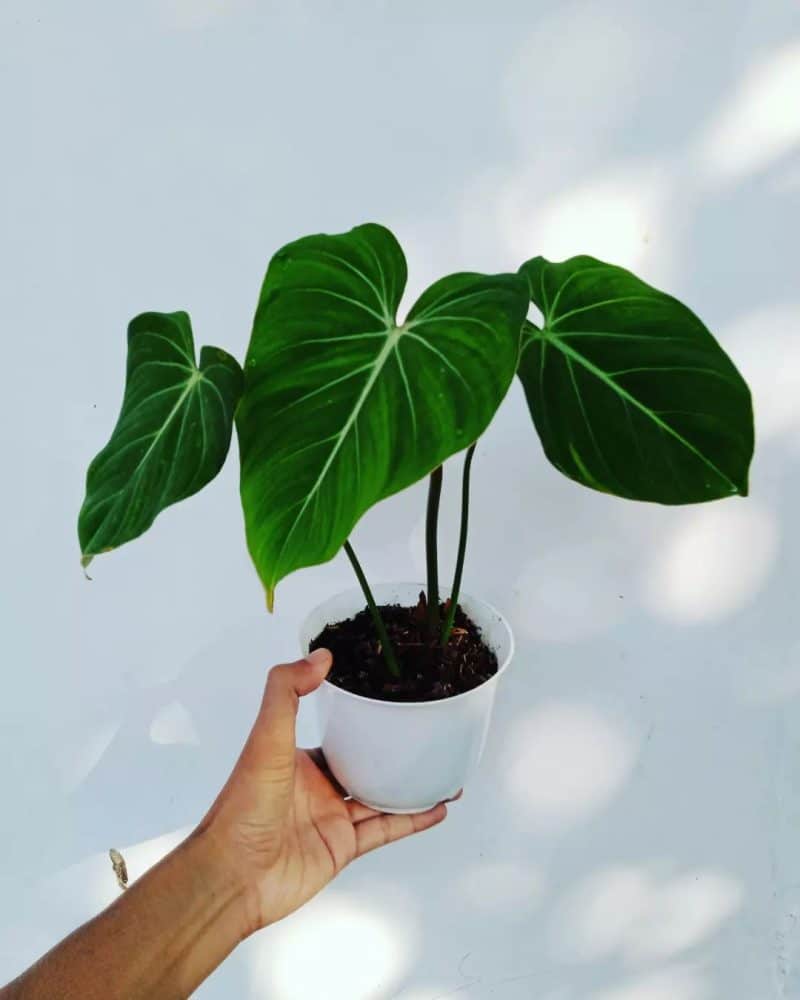
Philodendron gloriosum needs a well-draining soil mix to let its extensive root system breathe and prevent root rot. Since it does well in soil with a pH of 6.5 to 7.5, I highly recommend an all-purpose or orchid potting mix. You can add these to the composition to improve soil aeration:
- LECA
- Orchid Bark
- Perlite or Pumice (best source here)
- Peat
- Sphagnum moss
- Coco coir or coco cubes (hairy fiber from coconut husks)
- Vermicast
- Horticultural charcoal
Why charcoal, you ask? It helps mimic the charcoal produced by burnt trees during forest fires, which is part of the Philodendron gloriosum’s natural habitat. Charcoal also removes impurities and improves soil aeration.
Fertilize your plant with a 50% diluted balanced liquid houseplant fertilizer every month in the spring and summer. Give your plant a fertilizer break in fall and winter.
Do not over-fertilize the Philodendron gloriosum. This is a surefire way to cause chemical damage, which will show up as scorched or wilting plant leaves.
The plant’s stem grows horizontally, so a rectangular container that’s longer than it is wide will suit this varietal best. It’s time to repot when your Philodendron gloriosum is hanging over the edge of its pot or rootbound. This should take a few years if you’re using a wider, shallower pot.
If you use a round pot, your philodendron gloriosum will quickly run out of room to grow and lean over the sides. In this case, you’ll have to repot way more frequently – so stick with a longer pot.
Either way, make sure your pot has sufficient drainage holes, which will cut down on a lot of the issues that philodendron plants have.
Philodendron Gloriosum varietal types
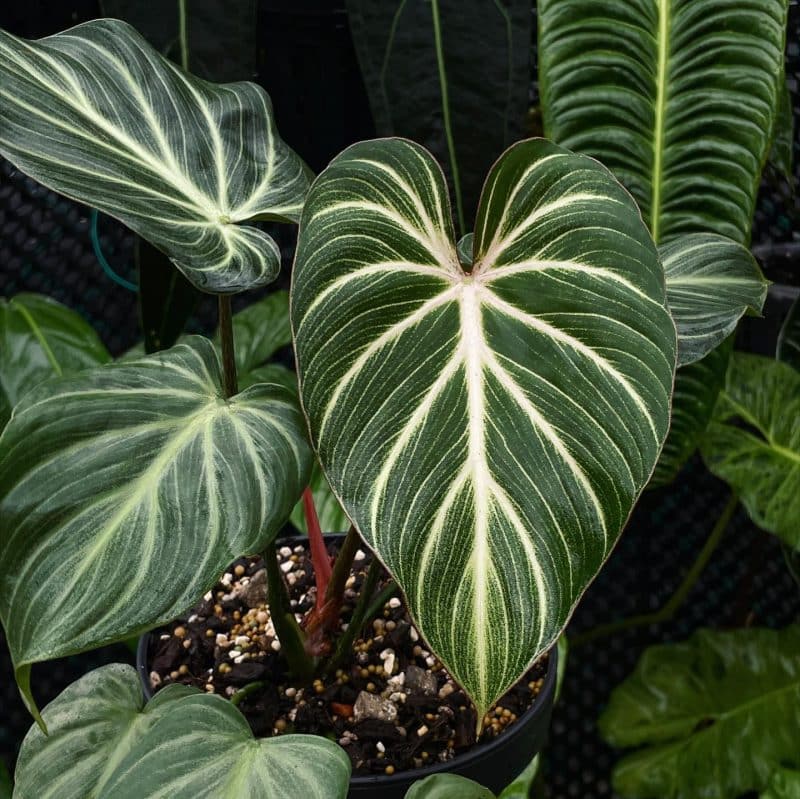
The Philodendron genus is the foundation for an impressive number of varieties and crossbreeds. Here is a quick overview of the different types of philodendron gloriosum species and what makes them stand out (and this isn’t even getting into the crossbreeds!):
- Philodendron gloriosum dark form. Very dark green leaves with prominent white veins and red edging
- Philodendron gloriosum pink back. Variant of the Philodendron gloriosum zebra with white veins on the top of the leaf and a pink hue on the underside
- Philodendron gloriosum round form. More rounded leaves that almost look like circles
- Philodendron gloriosum silver. Silver veins that become more prominent as the plant matures
- Philodendron gloriosum verde. Green to dark green leaves with less prominent white veins
- Philodendron gloriosum white veins. Very visible clear white veins
- Philodendron gloriosum zebra. Larger white and light green vein stripes than the original, like a zebra
So for whichever varietal you’ve picked, I’ll now cover the main ways to propagate it.
Propagation Guide
The Philodendron gloriosum grows from an underground stem called a rhizome. With many houseplants, we don’t have the option of a rhizome propagation, so I’ll explain exactly how that works:
Rhizome cutting propagation
- Remove the plant from its pot or leave it in and gently dust away top soil so the rhizome is visible.
- Cut the rhizome vertically between the leaves with a sharp sterilized pruner or scissors into as many portions as you want, ensuring that each piece has one or two leaves.
- At this point, you have two options, depending on whether your cutting has roots or not. If the rhizome you chopped has roots, you can plant it in a well draining potting mix, and that’s it! However, if your cutting lacks roots, you will need to root it.
To root a stem cutting, I recommend a mixture of 50% sphagnum moss and 50% perlite.
- Place the rhizome slightly in the moss. The upper half should always remain above the soil to prevent root rot. You can dip it in rooting hormone gel or powder first to encourage faster growth.
- Put a clear plastic bag on top of the cup to raise humidity. Make sure the bag is propped up so that it doesn’t touch the leaves.
- Your Philodendron gloriosum should grow roots within several weeks. Remember to remove the plastic bag every two or three days to promote air circulation.
- When roots are several inches long, you can plant stem cuttings in well-draining soil containing orchid bark potting mix.
Congratulations, you officially have a new Philodendron gloriosum!
Common Issues

Plants indoors have a lot of the same issues (spider mites, aphids, root rot, too much direct sunlight). I’ll detail how they might manifest with your plant and what you can do to resolve the issues.
Yellow leaves. This can be caused by either under watering or over watering (confusing, I know). Check with your finger to make sure there is slightly moist soil in the top two inches of the pot. If not, it’s time to water your gloriosum.
If the soil is already wet, make sure the container has large enough drainage holes to prevent waterlogging. Soggy soil can cause root rot and is this plant’s number one enemy. If you suspect root rot, make sure you’re using equal parts potting mix, orchid bark, and perlite to help aid soil drainage.
Droopy leaves. Your moisture levels are off somehow. If your plant is too wet, check for poor drainage, which can result in rotting roots. Also make sure it’s receiving enough light.
If your plant is too dry, give it a thorough watering immediately.
Browning tips. This can be a result of either too little water or too much direct sun. Either way, brown leaf tips are an early warning sign that shouldn’t be ignored.
If your plant is too dry, you need to water it thoroughly. If you have already done this, raise the humidity level in its environment. Consider using a humidifier.
If your P. gloriosum is getting too much sun, its leaves will scorch, or turn brown, beginning at the tips and continuing to the entire leaf. Move the plant farther from a window, or cover the window with a sheer fabric to lessen the impact of direct light.
Diseases and Pests
Philodendron gloriosum can fall victim to the same plant pests as other tropical plants, namely aphids, spider mites, mealybugs, fungus gnats, scale, and whitefly.
I recommend neem oil for any pest issues. There are two types, pure neem oil or diluted. The diluted version comes ready to spray.
Spray your gloriosum plant thoroughly, making sure to cover leaf tops and undersides. In two weeks, repeat the process to catch any pests you may have missed the first time.
Conclusion
Philodendron gloriosum grow slowly, but the payoff is gorgeous velvety green leaves with distinct colorful veins that can be pink, white, green, or even silver depending on the varietal. Collect them all!
This plant isn’t hard to take care of. Just remember that it can’t tolerate direct sun and prefers bright indirect light, high humidity, and a coarse potting mix.
Propagate your gloriosum via rhizome or stem cutting, and stick it in a long, wide pot to let its ground crawling nature shine. Be patient, and in a few months, you’ll have the large leaves and colorful veins this plant is known for.
If you liked this article, share it with your friends! As always, if you have any questions, let us know and we’ll do our best to give you the answer you need.
FAQ
What does the flower look like, will it bloom indoors?
The Philodendron gloriosum flower is white with a flowering spike, or spadix, encased by a cave-like leaf, or spathe. The plant rarely blooms indoors, but it is possible. If yours does bloom, please send in a picture!
How quickly does a Philodendron gloriosum grow?
Philodendron gloriosum is a slow growing plant. It may take two months from the time a leaf spike appears to when it unfurls to its full length.
Can I use a grow light?
Definitely! If your plant isn’t getting enough light, feel free to supplement with a grow light. Just make sure to keep it two feet from your plant’s leaves so as not to burn them.
Philodendron gloriosum vs glorious?
Philodendron glorious is a hybrid of Philodendron melanochrysum and Philodendron gloriosum, carrying some of the DNA of both. It was crossed in the 1970s by Keith Henderson.
Glorious is an epiphyte plant, or climber, while gloriosum is a terrestrial plant, or crawler. Another difference: The melanochrysum’s darker, wider leaves show up in the glorious.
Finally, it’s easier to care for the glorious because it grows larger leaves more quickly than the gloriosum, which means it’s a little less picky about light.

